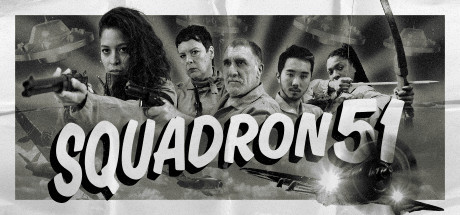
One of the biggest risks we’re taking is to fully embrace the concept of live-action cinematics. This is certainly not new in the history of videogames, but it became an unusual choice in recent decades. We’ve decided to stick with the “retro” charm of using real actors and on-set action to tell the story of the resistance against Director Zarog.
From arcade machines in the 1970’s to the peak of the point-and-click adventure games, the live-action FMV has became quite a trend in the 1990s. Let’s take a look at some examples that helped us solidify our confidence in the choices we’ve made in “Squadron 51”.
Sewer Shark
“Sewer Shark” is considered to be the first game on a console to feature a full-motion video gameplay. Afterwards, it was also released in a CD-Rom format, making it one of the most widely available games of the early 90s. In this SEGA rail-shooter, we’re presented to a militar dystopia, the player assumes the role of a rookie pilot to exterminated mutated creatures that are inhabiting the sewers.
[previewyoutube=aIb3armCCXA;full][/previewyoutube]
The 7th Guest
“The 7th Guest” is a point & click adventure developed by Trilobyte, originally released in 1993, and became a cult classic ever since. The game takes place in the past, and the story is told through a series of ghostly flashbacks shot in a very 90s way. The mansion is presented as a series of intricate 3D renderings of interior, with pre-rendered animated transitions between locations. Along the way, the player watches non-interactive in-game cutscenes, which use full-motion video (FMV) superimposed upon the backgrounds.
[previewyoutube=Zd36KUgAyxQ;full][/previewyoutube]
Wing Commander IV: The Price of Freedom
The Wing Commander franchise was a mark in the history of videogames for a variety of reasons, and its fourth installment is no different. The space flight simulator developed by Origin Systems featured the live-action sequences starring no other than Mark Hamill himself and also well-respected actors such as Malcom McDowell and John Rhys-Davies. For this production, instead of using blue-screen techniques seen in the previous game and in most of videogames, they built real sets. As a result, at the time of its release, Wing Commander IV became the most expensive video game ever made.
[previewyoutube=rYAcyeQQlq8;full][/previewyoutube]
Command and Conquer
Maybe the campiest franchise to use FMV as a trade-mark, the real-time strategy game is gaining sequels and remasters to this day, and most of them betting on using live-action cutscenes even if that’s a trend the industry widely abandoned. But the campy charm attracted cult actors such as Tim Curry, Peter Stormare, Udo Kier and Ray Wise to give arthouse legitimacy to the sequences, and the cheesy Cold-War paranoia feels are everywhere, as you can check below on these Command And Conquer: Red Alert III scenes.
[previewyoutube=at5sM6jdRNg;leftthumb][/previewyoutube]
Quantum Break
In the 2010’s, triple-A games became increasingly hyperrealistic, giving cinematographic vibes to its complex narratives, as you can see in renowned games such as the "Uncharted" and “The Last of Us” franchises, both from the studio Naughty Dog. On the verge of that, a smaller trend has been trying to retrieve the charm of the live-action FMV in a more serious tone. The epitome of that is seen in the ambitious Microsoft project “Quantum Break”, the time travel mystery that combines a high octane action 3D person shooter with a sci-fi thriller TV show. What makes “Quantum Break” unique is that the companion piece is optional, but the player who chooses to watch the “episodes” is presented with strategies and insights that highly impact the gameplay.
[previewyoutube=XWhg_1lLA1k;full][/previewyoutube]
If you’re still curious about the subject, you can check the Netflix Series' "High Score", about the history of the videogame industry. In the fifth episode, you'll see the very beginning of the merge between videogames and film industries when two developers had a mission to make a game within a year and decided to shoot real actors to be their actual playable characters in their upcoming fighting game called "Mortal Kombat". The episode also tells the time that a visual effects specialist from Hollywood had an idea for a horror game which would look like a movie, but the player could choose which scenes would happen and modify the narrative in "Night Trap". This two games stirred such controversy in the USA that it led to the 1993 Congressional hearings, pushing for the creation of the Entertainment Software Ratings Board (ESRB).
To learn more about FMV, check the following sites:
https://fmvworld.com/games.html.
https://www.giantbomb.com/full-motion-video/3015-604/games/
